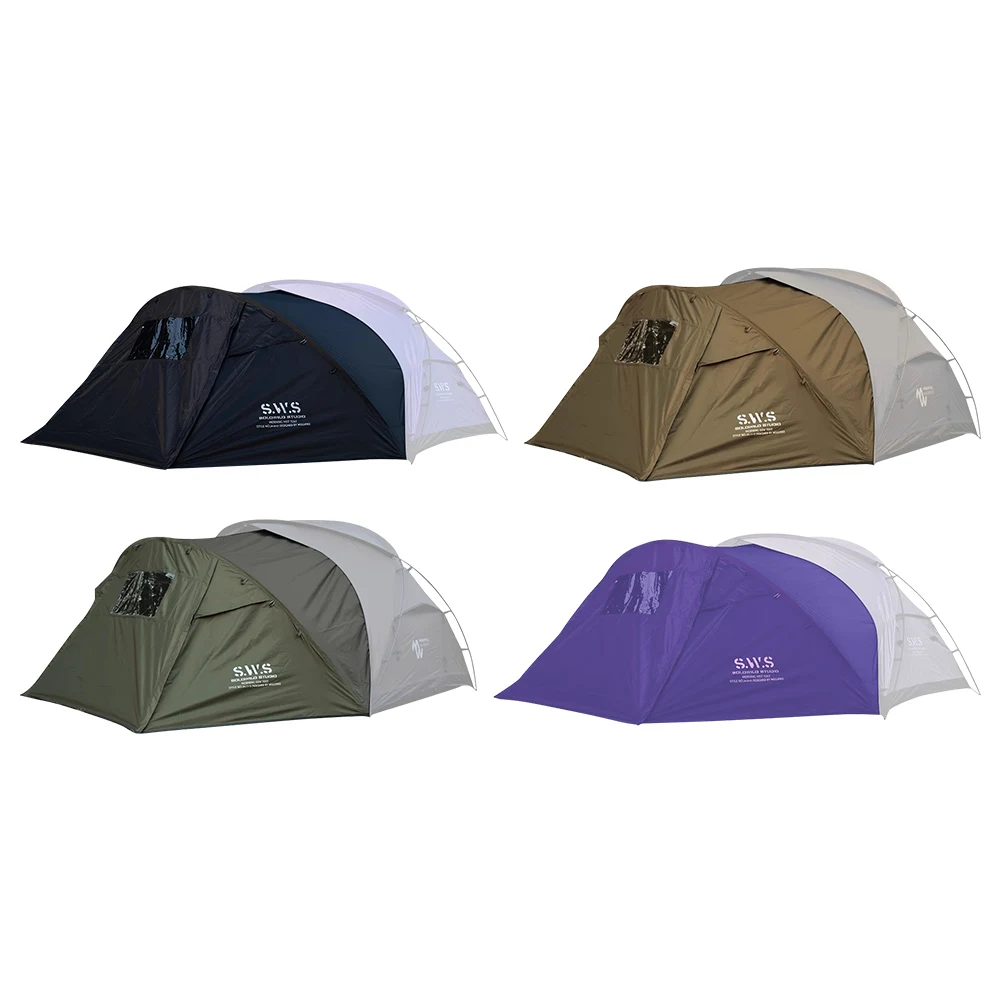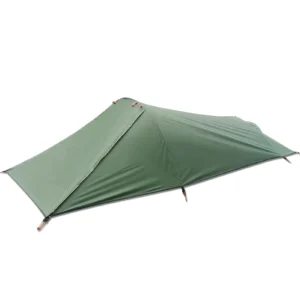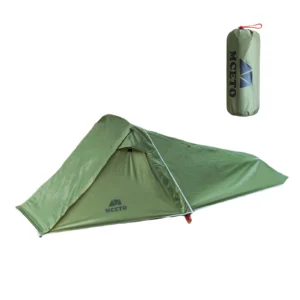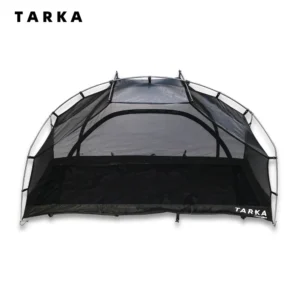Understanding Trekking Pole Tents
Trekking pole tents represent a clever evolution in backpacking shelter design, replacing traditional tent poles with the hiking poles you’re already carrying. Instead of packing dedicated tent poles, these innovative shelters utilize the trekking poles you use for hiking stability to create the tent’s structural framework.
The concept is brilliantly simple: why carry extra weight when you already have sturdy, adjustable poles in your pack? This approach emerged from the ultralight backpacking movement where every ounce matters. Early designs began as simple tarps propped up with hiking staffs, but today’s versions include sophisticated shelters with full bug protection and weather resistance.
These shelters have gained remarkable popularity among weight-conscious backpackers. The weight savings are significant – traditional tent poles typically add 8-16 ounces (227-454 grams) to your pack weight, while trekking pole tents eliminate this entirely. Among long-distance hikers on trails like the Pacific Crest Trail, adoption rates exceed 60% according to recent gear surveys.
Understanding different shelter options for two campers helps determine if trekking pole tents match your needs. The fundamental design difference is that traditional tents incorporate dedicated flexible poles that create tension and structure, while trekking pole tents transform your hiking aids into rigid vertical supports that lift and tension the fabric.
The mechanics behind how trekking pole tents work involve strategic placement of the poles to create tension across the fabric panels, resulting in remarkably stable structures despite their minimalist approach.
Core Advantages of Trekking Pole Tents
Trekking pole tents offer several compelling benefits that have contributed to their rising popularity among serious backpackers and hikers. These advantages extend beyond mere novelty to provide practical improvements to the backpacking experience.
The most obvious advantage is significant weight reduction. By eliminating dedicated tent poles, backpackers typically save 8-16 ounces (227-454 grams), which might seem small until you’re carrying it for miles. This weight reduction is a core principle of why trekking pole-supported shelters have become standard equipment for ultralight enthusiasts.
Multi-functionality represents another key benefit. Your trekking poles serve dual purposes – providing stability while hiking and supporting your shelter at camp. This “use what you carry” philosophy eliminates redundancy in your gear system.
Packability improves substantially with trekking pole tents. Without rigid poles, these shelters compress into remarkably small packages, reducing pack volume by approximately 15-25% compared to traditional tent designs. This space-saving benefit allows for smaller, more comfortable backpacks or room for additional supplies.
Additional advantages include:
- Simplified designs with fewer components to break or lose
- Cost effectiveness when already owning trekking poles
- More pitching options in challenging terrain
- Easier replacement of support poles (any stick of adequate length can substitute in emergencies)
- Better adaptability to uneven ground conditions
These benefits make trekking pole tents particularly appealing for thru-hikers, ultralight backpackers, and anyone seeking to reduce their load without sacrificing shelter quality.
Essential Compatibility Factors
Before purchasing either trekking poles or a tent designed for pole support, understanding compatibility factors is crucial. Many backpackers learn through frustrating experience that not all trekking poles work with all tents – a discovery you don’t want to make in the backcountry.
The most common compatibility misconception is that any trekking pole will work with any pole-supported tent. In reality, several critical specifications must align for a successful pairing. Recognizing these requirements helps avoid costly purchasing mistakes and camping disappointments.
Mastering two-person lightweight tent setup becomes much easier when your equipment properly matches. The compatibility hierarchy generally places pole length as the most critical factor, followed by locking mechanism reliability, tip design, and material strength.
Many trekking pole backpacking tents specify their exact pole requirements in product descriptions, but understanding these fundamental compatibility elements allows you to make informed decisions even when specific guidance is limited.
Let’s examine each compatibility factor in detail to ensure your poles and tent work harmoniously together for a secure, weather-resistant shelter.
Critical Pole Length Requirements
Adjustable length capability ranks as perhaps the most crucial compatibility factor when matching trekking poles to tents. Different tent designs require specific pole heights to achieve proper tension and structure. Using poles that are too short results in a saggy shelter with poor weather resistance, while poles that are too tall can damage fabric or create unstable configurations.
Most trekking pole tents require heights between 45-60 inches (115-152 cm), with pyramid-style shelters typically needing taller settings than A-frame designs. The required height often falls near the upper limit of many trekking poles’ adjustment range, making maximum height extension a critical specification.

To determine your tent’s required pole height:
1. Check the manufacturer’s specifications first
2. If unavailable, measure the height from the ground to the pole insertion point when properly tensioned
3. Add 1-2 inches to account for ground penetration and adjustment
Some tent designs utilize asymmetrical pole heights, requiring different measurements for front and rear poles. Understanding whether tent poles are interchangeable becomes important in these situations, as you’ll need poles that can be set to different heights.
A crucial but often overlooked consideration is the minimum packed length of your poles. For bikepacking or travel where pack size matters significantly, collapsible poles with shorter packed dimensions offer tremendous advantages despite sometimes weighing slightly more than fixed-length alternatives.
Locking Mechanisms and Stability
The pole locking mechanism directly affects tent stability, especially in challenging weather conditions. When supporting a shelter, trekking poles experience constant tension that tests the security of their adjustment systems. A pole that collapses under load will compromise your shelter’s integrity precisely when you need it most.
The main locking systems include:
Lever locks (external flip locks): Generally provide the strongest hold under tension and easy adjustment even with gloves. They rarely slip once properly tightened, making them excellent for tent support. However, they add slight bulk and weight.
Twist locks (internal expansion): Offer clean profiles and light weight, but may gradually loosen under constant tension. Their performance varies significantly between brands, with premium models performing far better than budget options.
Push-button locks: Common on fixed-section poles but rare on adjustable models. They provide absolute security against compression but allow no length adjustment, limiting tent compatibility.
Under tent tension, poles experience both downward pressure and lateral forces. Quality locking mechanisms maintain their set length even when supporting a tent in windy conditions or when bumped during camp activities. Budget poles with inferior locks often slip gradually during the night, resulting in a sagging shelter by morning.
For tent use, particularly in adverse conditions, external lever locks typically offer the most reliable performance and easiest field adjustability.
Pole Tip Design and Compatibility
Trekking pole tips must properly interface with your tent’s attachment points for secure setup. Most trekking pole tents accommodate standard carbide tips, but compatibility issues can arise with specialized designs or when tips have unusual shapes or dimensions.
Common tip configurations include:
- Standard carbide tips: Work with most tent grommets and pocket inserts
- Wide basket tips: May not fit through some tent grommets
- Rubber walking tips: Often too wide for grommet insertion
- Specialized shock-absorbing tips: Variable compatibility depending on design
Many tents require poles to be used in “handle-down” orientation for proper fit. This position places the pole tip upward inside the tent, which can potentially damage the fabric. Protective caps or tip covers are essential accessories in these cases to prevent puncturing your shelter.
For tents using “tip-down” orientation, consider ground conditions. Hard surfaces may damage carbide tips, while soft ground might allow poles to sink. Aftermarket rubber tip covers or specialized tent “pole plates” solve these issues by providing wider surface area for stability.
The best ultralight trekking pole tents are designed with versatile attachment points that accommodate various tip designs, but always verify compatibility before purchasing.
Material Strength and Durability Considerations
Trekking poles for tent support must withstand constant tension while maintaining structural integrity. The material composition directly affects their reliability in shelter applications.
Common pole materials include:
Aluminum: Typically 7000-series aluminum offers excellent strength-to-weight ratio with moderate flex. Aluminum poles bend under extreme stress rather than catastrophically failing, allowing emergency repairs. They’re heavier than carbon alternatives but more affordable and durable against impacts.
Carbon fiber: Provides superior weight savings (20-30% lighter than aluminum) with excellent rigidity. However, carbon poles can shatter under extreme lateral stress or sharp impacts. Their rigidity minimizes flex under tent tension, creating very stable shelters in controlled conditions.
Composite (carbon/aluminum combinations): Offers balanced performance with aluminum sections in high-stress areas and carbon elsewhere. These hybrid designs combine durability with weight savings.
For tent applications, flex characteristics matter significantly. Some tent designs rely on slight pole flex to achieve proper tension, while others require rigid support. Understanding lightweight trekking shelter materials helps match pole flexibility to tent design requirements.
Weather conditions also influence material selection. Carbon fiber maintains its properties in extreme cold where aluminum becomes more brittle. Conversely, aluminum better withstands the abuse of rocky terrain where carbon might chip or crack.
Practical Benefits and Challenges
While trekking pole tents offer compelling advantages, they also present unique challenges. Understanding both sides helps set realistic expectations for your backpacking experience.
Beyond weight savings, practical benefits include:
- Improved stability in certain conditions, as trekking poles often provide broader support bases than thin tent poles
- Better adaptability to uneven terrain where traditional pole structures might twist
- Simplified replacement if damaged (any sturdy stick of appropriate length can substitute)
- Reduced pack noise since there are no rattling poles
- Smaller packed volume creating more usable space in your backpack
However, honest assessment reveals several challenges:
- Steeper learning curve for proper setup and tensioning
- Reduced interior living space compared to dome tents of similar weight
- Potentially compromised stability in extreme winds depending on design
- Limited freestanding capability, requiring proper staking in most cases
- Compatibility issues between specific pole and tent models
Several disadvantages of trekking poles carry over to their tent application. These include potential pole damage from supporting shelters and the need to store wet poles inside your pack after breaking camp in rainy conditions.
The real-world performance balance varies significantly based on terrain, weather conditions, and user experience. Many backpackers find that after an initial adjustment period, trekking pole tents offer an excellent compromise of weight, packability, and function.
Selecting the Ideal Trekking Poles for Your Tent
Choosing trekking poles specifically for tent support requires prioritizing certain features over others. While hiking performance remains important, tent compatibility introduces additional selection criteria.
When evaluating potential poles, prioritize these tent-specific features:
- Adequate maximum length matching your tent’s requirements (typically 47-58 inches)
- Robust locking mechanisms that won’t slip under constant tension
- Durable materials appropriate for your intended conditions
- Compatible tip design that interfaces with your tent’s attachment system
- Adjustment range that accommodates both walking comfort and tent height
For most users, sturdy lever-lock aluminum poles represent the best balance of reliability, compatibility, and value. Carbon fiber options offer weight advantages but require more careful handling to prevent damage when supporting shelters.
When choosing the ultimate compact shelter for two, consider your poles as part of an integrated system rather than separate components. The perfect pole-tent combination provides reliable shelter while serving double-duty as hiking aids.
Budget considerations also affect selection. Premium poles ($150-$200) often provide better long-term performance for tent use, but mid-range options ($80-$120) can offer excellent value with only slight weight penalties or minor convenience compromises.
Top Trekking Poles for Tent Support
Certain trekking pole models consistently outperform others when used for tent support. The following options have proven particularly reliable for shelter applications based on their combination of strength, adjustability, and locking security.
Top performers typically feature:
– Maximum heights of 51-59 inches (130-150 cm)
– Robust external lever locks or premium twist locks
– Durable aluminum or high-quality carbon fiber construction
– Weight ranges of 14-20 ounces (400-570 grams) per pair
– Versatile tip options with accessory baskets
When evaluating specific models, premium options from established outdoor brands generally offer the most reliable performance for tent applications. Look for poles with maximum height ratings at least 2 inches above your tent’s required pole length to ensure adequate adjustment range.
The most compatible poles feature lever-lock mechanisms that maintain tension even when bumped or subjected to wind pressure. Models with extended grips allow more flexible height adjustment when used in handle-down orientation.
Many lightweight backpacking tents work best with poles featuring standard carbide tips and removable baskets. Consider whether your tent requires handle-up or tip-up orientation, as this affects which pole features become most important.
Lightweight Backpacking Tent, Ultralight Backpacking Tent, Ultralight Bivy Tent
Ultralight Single Person Camping Tent with Aluminum Poles for 3-Season Backpacking Waterproof DesignPrice range: $94.88 through $326.82 Select options This product has multiple variants. The options may be chosen on the product pageLightweight Backpacking Tent, Ultralight Backpacking Tent, Waterproof Backpacking Tent
$391.05 Select options This product has multiple variants. The options may be chosen on the product pageCompact Backpacking Tent, Lightweight Backpacking Tent, Waterproof Camping Tent
$335.52 Select options This product has multiple variants. The options may be chosen on the product pageBackpacking Tent with Vestibule, Freestanding Backpacking Tent, Lightweight Backpacking Tent
Price range: $446.89 through $447.22 Select options This product has multiple variants. The options may be chosen on the product pageBackpacking Tent with Vestibule, Trekking Pole Backpacking Tent, Waterproof Camping Tent
Price range: $271.99 through $519.52 Select options This product has multiple variants. The options may be chosen on the product pageUltralight Backpacking Tent, Ultralight Trekking Pole Tent
Price range: $350.87 through $351.98 Select options This product has multiple variants. The options may be chosen on the product page
Common Tent Designs Using Trekking Poles
Trekking pole tents come in diverse architectural styles, each with distinct characteristics and pole requirements. Understanding these design categories helps match appropriate poles to specific tent types.
Popular designs include:
Pyramid (Mid) Tents: These simple, sloped-wall shelters use one central pole (or two poles joined together) to create a pyramid shape. They excel in wind resistance and snow-shedding capability but sacrifice some interior space due to sloped walls. Pyramid tents typically require the tallest pole heights, often 54-58 inches (137-147 cm).
A-Frame Shelters: Modern interpretations of classic pup tents, these designs use two poles at opposite ends with a ridgeline between them. They offer excellent headroom along the center line but less at the sides. Typical pole height requirements are 45-52 inches (114-132 cm).
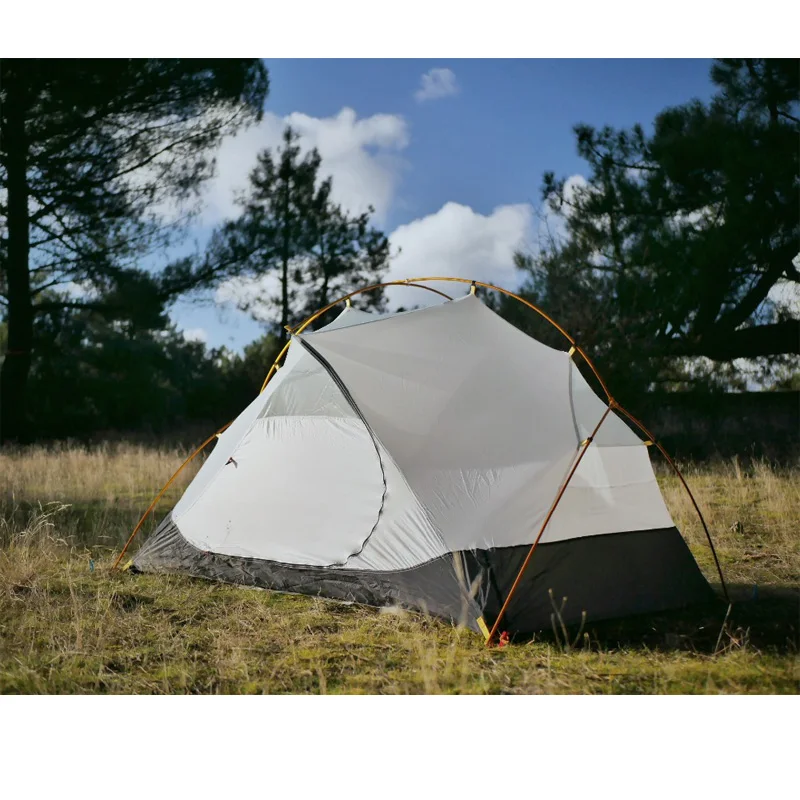
Hybrid Designs: These shelters combine trekking pole support with short tent pole segments to create more livable interior spaces. They represent an excellent middle ground between traditional and trekking pole tents.
Single-Wall vs. Double-Wall Construction: Beyond their architectural shape, trekking pole tents may feature single-wall construction (where one layer serves as both rainfly and tent body) or double-wall design (separate inner tent and rainfly). Single-wall designs save weight but may have condensation challenges, while double-wall versions manage moisture better but weigh slightly more.
The trekking pole tent guide explores these designs in greater detail, but the key consideration for pole compatibility is understanding the height and strength requirements of each architectural style.
Matching Poles to Specific Tent Models
Finding perfect compatibility between specific trekking poles and tent models requires research and attention to detail. Manufacturer specifications provide the most reliable guidance, but these tips help navigate compatibility when information is limited.
When researching compatibility:
1. Check the tent manufacturer’s website for recommended pole specifications
2. Review the tent’s setup instructions for specific height requirements
3. Search user forums and reviews for real-world compatibility reports
4. Contact customer service if specifications are unclear
For many popular models, required pole heights include:
– Pyramid midsize shelters: 52-58 inches (132-147 cm)
– A-frame tarp tents: 45-50 inches (114-127 cm)
– Hybrid designs: Variable, typically 48-54 inches (122-137 cm)
When adapting poles to challenging tent designs, adjustable-length models offer the greatest versatility. Some specialized techniques include using trekking poles upside down, adding pole jacks or extenders for additional height, or employing pole adapters to create more secure interfaces.
For the best weather protection, many waterproof backpacking tents have specific pole recommendations to ensure proper tension and stability during storms.
Expert Setup Tips and Techniques
Mastering trekking pole tent setup transforms these ultralight shelters from frustrating puzzles into reliable backcountry homes. These expert techniques ensure secure, weather-resistant pitches every time.
Site Selection Fundamentals:
– Choose level ground with good drainage
– Remove sharp objects that could damage your tent floor
– Consider natural windbreaks in exposed areas
– Avoid depressions where water might collect
Perfect Pitching Sequence:
1. Plan pole positions before unpacking
2. Stake out main corners loosely
3. Insert and adjust trekking poles to proper height
4. Create initial tension with key stake points
5. Make systematic adjustments working around the shelter
6. Fine-tune overall tension and symmetry
Tension Management:
The secret to a storm-worthy pitch lies in even tension distribution. Start with corner stake points, then systematically work around the shelter, creating consistent tension across all panels. Many mastering trekking pole tent setup guides emphasize this systematic approach.
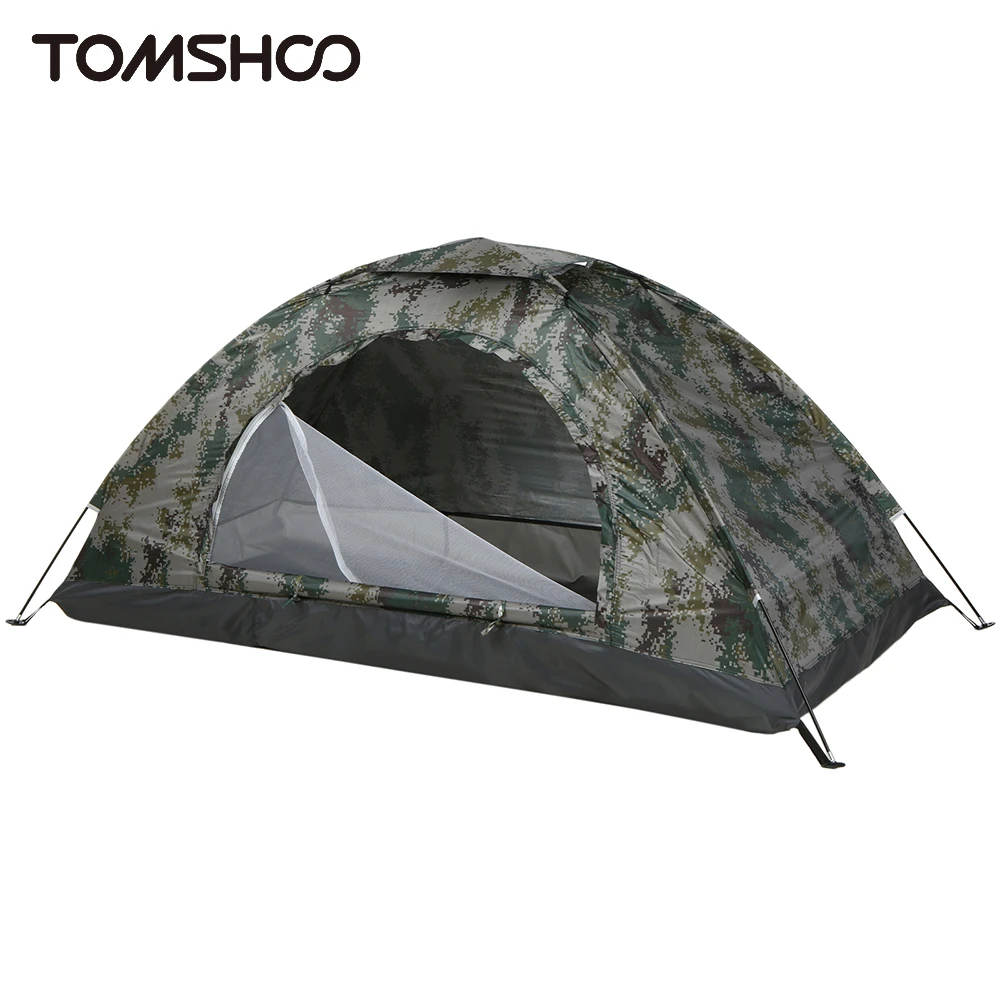
Common Problems and Solutions:
– Sagging fabric: Increase pole height incrementally
– Unstable poles: Use wider pole baskets or “pole plates” on soft ground
– Uneven tension: Readjust stake positions to create symmetrical tension
– Flapping in wind: Add supplementary guy lines at midpoints
How to set up trekking pole tents varies slightly between designs, but these fundamental principles apply universally. The most common setup mistake is rushing the process – taking an extra few minutes for proper tensioning saves hours of frustration during storms.
Maintenance and Care Best Practices
Proper maintenance extends the lifespan of both your trekking poles and tent while ensuring reliable performance when you need it most. Following these care practices prevents common failures and maintains compatibility.
Trekking Pole Inspection Routine:
– Check locking mechanisms for smooth operation before each trip
– Inspect pole shafts for cracks, dents or deformation
– Clean dirt from adjustment points and moving parts
– Examine tips for excessive wear or damage
– Test lock security under load before relying on them for shelter support
Preventative Maintenance:
– Lubricate moving parts with manufacturer-recommended products
– Tighten any loose external screws on locking mechanisms
– Replace worn ferrules or tips before they cause shaft damage
– Store poles extended (not fully collapsed) to reduce spring tension
– Keep poles away from extreme heat which can damage carbon fiber
Protecting Your Tent:
– Use protective caps on pole tips when used inside tent pockets
– Place small fabric patches at pole contact points to prevent abrasion
– Clean poles before insertion to prevent grit from damaging tent materials
– Consider pole plates or “footprints” under pole tips to prevent floor punctures
Many compact backpacking tents benefit from these maintenance practices, extending their useful life while ensuring compatibility with your trekking poles remains optimal.
Frequently Asked Questions
Can any trekking pole work with a trekking pole tent?
No, compatibility depends on several factors including maximum pole height, locking mechanism security, tip design, and material strength. Most tents require poles that extend to at least 48 inches (122 cm) with reliable locks that won’t slip under tension.
What’s the ideal pole length for most tent designs?
Most trekking pole tents require poles adjustable to 48-55 inches (122-140 cm), though pyramid shelters may need up to 58-60 inches (147-152 cm). Always check manufacturer specifications for exact requirements.
How stable are trekking pole tents in high winds?
When properly pitched, many trekking pole tent designs excel in high winds due to their low profiles and aerodynamic shapes. Stability depends on correct tensioning, secure staking, strategic site selection, and appropriate pole strength.
Do I need special tips or adaptors for my poles?
Most tents accommodate standard carbide tips, but some designs may require protective caps when poles are used in handle-down orientation. Wide baskets or aftermarket “pole plates” improve stability on soft ground.
Are carbon fiber or aluminum poles better for tent support?
Both materials work well with different trade-offs. Carbon fiber poles are lighter but more vulnerable to breakage from lateral stress. Aluminum poles are more durable and usually less expensive but slightly heavier. For most users, quality aluminum poles offer the best balance of durability and performance.
How do I prevent poles from sinking in soft ground?
Use wider baskets on your pole tips or add aftermarket “pole plates” that distribute weight over a larger surface area. In snow, creating compacted platforms under each pole significantly improves stability.
What if my poles aren’t adjustable?
Fixed-length poles severely limit tent compatibility. Some workarounds include using pole jacks (extenders), modifying your pitching technique, or adding height with stable objects under pole tips, though these solutions compromise stability.
Alternative Support Solutions
When trekking poles aren’t available or suitable, several alternative tent support options exist. These solutions range from commercial products to improvised field techniques.
Dedicated Collapsible Tent Poles:
Specialized ultralight tent poles offer an excellent alternative for users who don’t hike with trekking poles. These typically weigh 2-4 ounces (57-113 grams) per pole and collapse to compact dimensions. Though they add weight compared to using existing trekking poles, they’re still significantly lighter than traditional tent pole sets.
Natural Materials:
In emergency situations, appropriately sized branches can substitute for trekking poles. Look for sturdy, straight sections with Y-shaped ends to prevent puncturing the tent. This method requires careful selection and preparation to avoid damaging your shelter.
Improvised Supports:
Other creative solutions include lashing hiking staffs together for added height, using paddle shafts for packraft/tent combinations, or creating A-frame supports from found materials. These approaches trade convenience for adaptability in challenging situations.
Hybrid Support Systems:
Some innovative backpackers combine short pole segments with trekking poles or natural materials to create custom support systems. These personalized solutions can address specific terrain challenges or tent design limitations.
When selecting alternatives, prioritize rigid supports that won’t compress under the tension required for proper tent pitching. Weight considerations remain important, but reliability should take precedence for safety and shelter integrity.
Advanced Tent Configurations
Experienced trekking pole tent users often develop specialized pitching configurations that maximize performance in challenging conditions. These advanced setups require precise pole adjustments and strategic tensioning.
Storm-Mode Configurations:
Many trekking pole tents allow for lowered storm pitches where the entire shelter sits closer to the ground. This modification typically requires shortening pole height by 2-4 inches (5-10 cm) and adjusting guy lines accordingly. The resulting lower profile dramatically improves wind resistance at the cost of some interior space.
Ventilation-Enhanced Setups:
In hot, humid conditions, specialized high-ventilation configurations utilize asymmetrical pole heights to create improved airflow. By setting windward poles slightly higher and adjusting guy line tension, users create ventilation channels that reduce condensation without sacrificing weather protection.
Snow-Load Adaptations:
Winter camping requires reinforced pitching techniques to handle snow loads. Additional crossing poles, steeper wall angles, and supplementary guy lines transform three-season trekking pole tents into capable winter shelters. These modifications typically require very strong poles at their maximum height settings.
Multi-Shelter Combinations:
Advanced users sometimes combine multiple trekking pole shelters to create expanded living spaces. By strategically positioning tents with shared walls or connected vestibules, these configurations create surprisingly livable backcountry accommodations while still maintaining reasonable weight.
These specialized setups demonstrate the remarkable versatility of quality trekking poles when paired with well-designed tents. As you gain experience, experimenting with these advanced configurations can significantly extend your shelter’s performance range across diverse conditions.

